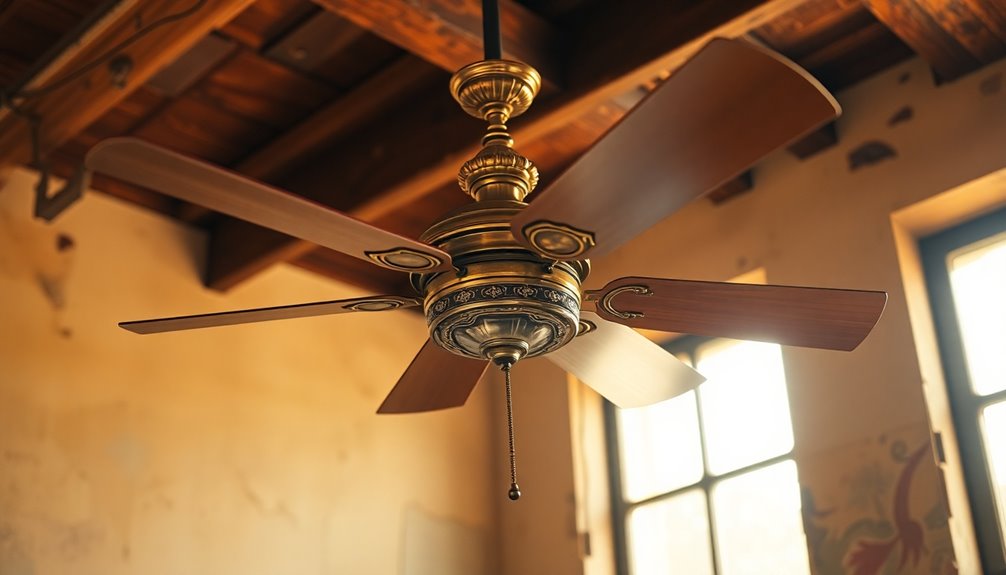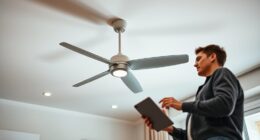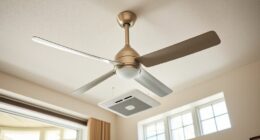Ceiling fans have fascinating origins, dating back to the 6th century B.C. in West Asia. However, the first mechanical ceiling fan, known as the punkah, emerged in India during the 17th century. These fans were luxurious items and often operated manually. It wasn't until 1887 that Philip Diehl invented the first electric ceiling fan, revolutionizing the design and making it more accessible. By the 1920s, the four-blade model became popular for its efficient airflow and quieter operation. Interested in how ceiling fans have evolved since then and their impact today? There's a lot more to uncover!
Key Takeaways
- The first known ceiling fans, called punkahs, originated in India during the 17th century.
- Philip Diehl invented the first electric ceiling fan in 1887, patenting it in 1889.
- Early U.S. ceiling fans emerged in the 1860s, powered by water turbines.
- The transition to electric fans gained momentum post-1887, leading to widespread popularity.
- By the 1920s, four-blade designs became standard for improved airflow and reduced noise.
Origins of Ceiling Fans

The history of ceiling fans reveals their fascinating evolution from simple designs to modern conveniences.
Originating in West Asia, evidence suggests that early designs date back to the 6th century B.C. However, the first known ceiling fans, called punkahs, emerged in India during the 17th century.
These manually operated fans were luxury items, initially found in the homes of royalty and British officers. Servants known as punkahwallahs would pull ropes to create a cooling breeze, showcasing the ingenuity of early fan designs.
The Invention by Philip Diehl

Building on the rich history of ceiling fans, the invention by Philip Diehl in 1887 marked a noteworthy turning point in their evolution. This German-American inventor utilized a sewing machine motor to create the first electric ceiling fan, distinguishing it from the manually operated fans that preceded it. In 1889, Diehl received a patent for his innovative design, which formally recognized his contribution to this essential household appliance.
Following the patent, Diehl & Co. began mass production of ceiling fans, making them widely available and greatly boosting their popularity. This move transformed ceiling fans from a luxury item into a common feature in homes across America.
The combination of Diehl's electric motor and the earlier electric fan concept developed by Schuyler Skaats Wheeler laid the groundwork for what we now know as the modern ceiling fan. Furthermore, the principles of color accuracy in other technologies highlight the importance of efficiency and design in home appliances, including ceiling fans.
Thanks to Diehl's pioneering work, ceiling fans became more efficient and effective, providing comfort and convenience in homes. His invention not only changed how people cooled their spaces but also set the stage for innovations in fan technology that continue to evolve today.
Early Designs and Features

Exploring early designs of ceiling fans reveals a fascinating evolution focused on efficiency and functionality. The first ceiling fan, invented by Philip Diehl in 1887, utilized a sewing machine motor to power its blades. These early designs typically featured two blades, emphasizing energy-efficient operation with low power consumption. Initially, these fans were primarily intended for commercial use, effectively cooling large spaces like department stores and restaurants.
As the popularity of ceiling fans grew, their designs evolved. By the 1920s, four-blade models emerged to provide quieter operation and improved airflow for households. This shift marked a significant change in the ceiling fan's appeal, allowing it to become a staple in homes.
Here's a quick overview of these early designs:
| Year | Design Features | Main Use |
|---|---|---|
| 1887 | 2 blades, sewing machine motor | Commercial use |
| 1890 | Energy-efficient, low power | Restaurants |
| 1920s | 4 blades, quieter operation | Residential use |
| 1889 | Patent granted for mass production | Start of electric ceiling fans |
These innovations laid the groundwork for today's ceiling fans, which continue to prioritize efficiency and functionality.
Evolution in the United States

When you look at the evolution of ceiling fans in the United States, you'll see they started in commercial spaces during the 1860s with water-powered models.
The electric fan revolution of the 1880s transformed their use, making them popular in households by the 1920s.
However, as air conditioning gained traction in the 1950s, ceiling fans began to decline in popularity.
Early Commercial Applications
Emerging in the early 1860s, ceiling fans quickly became a popular choice for commercial spaces across the United States. The first ceiling fans, which utilized water-powered turbines and featured two blades, offered an effective solution for air circulation in stores and restaurants.
Business owners appreciated their ability to create a comfortable environment for customers, enhancing the overall experience in these establishments.
As the technology evolved, the introduction of electric ceiling fans in the 1880s marked a turning point. These fans, particularly those designed by Philip Diehl, further increased efficiency and reliability.
With the growing appeal of ceiling fans, marketing efforts began to target affluent buyers by the 1910s, promoting their potential for household use. This shift helped solidify ceiling fans as essential fixtures in many homes.
However, the 1920s ushered in a golden age for ceiling fans, establishing them as household staples.
Yet, by the 1950s, a decline in popularity occurred as air conditioning technologies rose to prominence, leading to a shift in how people sought comfort in their environments.
Electric Fan Revolution
The advent of electric ceiling fans marked a pivotal shift in comfort technology in the United States. In the early 1860s, ceiling fans appeared, powered by running water and turbines, featuring just two blades.
Fast forward to 1882, when Philip Diehl invented the ceiling fan that changed everything. This innovation led to the first electrically powered fans, making air circulation more efficient and accessible.
By 1896, the introduction of alternating current revolutionized the electric fan market, allowing homes and businesses to adopt this technology widely.
By 1910, ceiling fans gained traction in commercial spaces like stores and restaurants, prompting manufacturers to ramp up household marketing efforts. You could find fans in more and more homes, enhancing comfort during hot months.
The 1920s brought further advancements, introducing four-bladed fans that improved operational efficiency and reduced noise. This solidified electric ceiling fans as a staple in American households.
As energy crises began to emerge, the ability of ceiling fans to provide relief without excessive energy consumption became increasingly valuable. The electric fan revolution truly transformed the way you experience comfort in your living space.
Mid-Century Decline
During the mid-20th century, ceiling fans often fell out of favor in the United States as air conditioning became the go-to solution for cooling homes and businesses. With air conditioning providing substantial temperature control, many saw ceiling fans as less effective for their cooling needs. This shift marked a significant decline in the popularity of ceiling fans, as people turned to the comfort of centralized cooling systems around the 1950s.
However, while you might've noticed this decline in the U.S., ceiling fans still thrived in many hot climates worldwide, such as India and the Middle East. These regions recognized the value of ceiling fans for their cooling capabilities and energy efficiency.
The late 20th century brought a turning point. Following the 1970s energy crisis, modern designs and energy-efficient technology led to a resurgence in ceiling fan popularity. By then, consumers began to appreciate ceiling fans for their versatility and cost-effectiveness.
As you can see, the journey of ceiling fans reflects changing preferences and technologies, ultimately proving their enduring relevance in managing indoor climates.
Technological Advancements Over Time

You might find it fascinating how ceiling fans have evolved from early mechanical innovations to today's smart technology.
The development of electric motors revolutionized their functionality, making them more efficient and reliable. Many of today's energy-efficient motors also incorporate advanced technology that enhances performance and reduces noise levels.
Now, modern fans often come equipped with smart features that enhance convenience and energy savings, showcasing just how far this technology has come. Additionally, the integration of energy-efficient models can significantly reduce electricity costs, similar to advancements seen in heat pump technology.
Early Mechanical Innovations
In the domain of early mechanical innovations, ceiling fans represent a fascinating evolution of design and technology. The first electric ceiling fan was invented by Philip Diehl in 1882, utilizing a sewing machine motor for operation. This was a pivotal moment that showcased how ingenuity could transform everyday comfort.
Initially, ceiling fans in the U.S. during the 1860s were powered by water turbines and featured just two blades, making them less efficient. However, by the 1920s, four-bladed ceiling fans became standard, offering quieter operation and improved airflow.
Consider these emotional milestones in the journey of ceiling fans:
- The relief of a cool breeze on a sweltering day
- The delightful hum of a fan soothing you to sleep
- The nostalgia of gathering under a fan at family events
- The pride in owning a device that merges function and design
- The anticipation of a summer evening made comfortable
The introduction of alternating current in 1896 made electric ceiling fans more efficient, while the development of Brushless Direct Current motors in the 1960s further enhanced energy efficiency and reduced maintenance needs, marking a significant leap in early mechanical innovations.
Electric Motor Development
The evolution of ceiling fans didn't stop with Philip Diehl's groundbreaking design; it continued to thrive through significant advancements in electric motor technology. After Diehl's initial invention in 1887, the electric ceiling fan quickly gained popularity.
By the 1920s, fans evolved from two blades to four-blade designs, which improved airflow efficiency and reduced noise. This change marked an important milestone in fan design, making your home more comfortable without the disruptive sounds of earlier models. Additionally, the focus on noise reduction technology in modern appliances has enhanced user experience. Furthermore, these advancements parallel the development of heat pump technology, which also emphasizes efficiency and comfort. The continual emphasis on airflow efficiency has driven manufacturers to create quieter and more effective ceiling fans.
Then came the 1960s, when the introduction of Brushless Direct Current (BLDC) motors revolutionized ceiling fans. These modern motors operate at lower voltages, leading to a drastic reduction in power consumption.
With BLDC motors, you can enjoy a steady airflow while being mindful of your energy bill. Furthermore, regular maintenance of ceiling fans can enhance their efficiency over time, similar to how heat pump maintenance improves overall performance.
Today, the advancements in electric motor technology continue to redefine ceiling fans. The integration of smart features may be on the horizon, but it's the development of efficient electric motors that laid the foundation for the fans you rely on now.
Embracing these innovations has made ceiling fans not just a necessity, but a blend of comfort and efficiency.
Modern Smart Features
As technology advances, ceiling fans have transformed into smart devices that enhance convenience and efficiency in your home. With the introduction of smart technology, modern ceiling fans allow you to control settings effortlessly through a remote control or a mobile app.
Imagine adjusting your fan speed or lighting without leaving your couch!
Here are some features that make these fans a must-have:
- Energy-efficient: Reduced energy consumption means lower bills.
- Quieter operation: Enjoy serenity with minimal noise disturbances.
- Integrated LED lighting: Illuminate your space while cooling it simultaneously.
- Voice control: Seamlessly integrate with smart home systems for hands-free operation.
- Stylish designs: Enhance your home décor with modern aesthetics.
The evolution from traditional designs to contemporary models equipped with Brushless Direct Current (BLDC) motors has greatly improved performance. Energy-efficient technology is also crucial in reducing overall energy consumption across various appliances, including ceiling fans.
These motors not only increase airflow but also enhance the overall efficiency of your ceiling fan.
With all these advancements, you'll find that a modern ceiling fan isn't just an appliance; it's a smart addition that simplifies your lifestyle.
Embrace the future of home comfort!
Current Popularity and Usage

Ceiling fans enjoy significant popularity around the world, especially in regions with hot climates. In the United States, their use of ceiling fans began to soar again during the 1970s energy crisis, when people sought cost-effective cooling alternatives to air conditioning.
Although the popularity of ceiling fans declined in the 1950s, they remain widely embraced in many countries, particularly in hot and humid environments like Asia and Africa.
Today, you'll find modern ceiling fans featuring advanced technologies, such as smart functionality that allows for remote control and app integration. This tech enhancement not only boosts convenience but also elevates the overall user experience.
The versatile designs of ceiling fans cater to diverse aesthetic preferences, making them a stylish choice for your home while also providing practical air circulation.
With fierce competition among manufacturers, ceiling fans continue to evolve, ensuring they meet the needs of contemporary consumers.
Whether you're looking to cool down a room or add a touch of elegance to your decor, the current popularity and usage of ceiling fans reflect their essential role in creating comfortable living spaces.
Cultural Impact and Significance

A ceiling fan isn't just a functional appliance; it represents a rich tapestry of cultural significance and historical evolution. From the manual punkah of 17th-century India to today's energy-efficient electric models, ceiling fans have come to symbolize comfort and innovation. Their ability to combat hot air in humid climates makes them essential in many households, particularly in countries like India where they're a staple.
- A symbol of luxury in elite dining settings.
- A blend of tradition and modern technology.
- A bridge connecting various cultures and lifestyles.
- A reflection of the importance of comfort in daily life.
- A demonstration of changing consumer preferences toward energy efficiency.
The cultural significance of ceiling fan installation lies in its adaptability across different environments. As you enjoy a gentle breeze, you're not just keeping cool; you're partaking in a historical narrative that's evolved to meet the needs of society.
Ceiling fans have transcended their basic functionality, becoming an integral part of our living spaces and a reminder of how innovation shapes our comfort.
Frequently Asked Questions
What Year Did Ceiling Fans Become Popular?
Ceiling fans really took off in the U.S. during the 1920s, becoming a must-have in homes, especially among affluent buyers.
Before that, by 1910, you'd notice them popping up in commercial spaces like stores and restaurants.
However, their popularity dipped in the 1950s with air conditioning's rise.
The energy crisis in the 1970s brought them back into the spotlight as people looked for cost-effective cooling solutions.
Did They Have Ceiling Fans in the 1920S?
Yes, you'd definitely find ceiling fans in the 1920s. During this decade, they became popular in households, especially among wealthier families.
You'd notice four-bladed designs emerging, which offered better performance and quieter operation. Marketing emphasized their cooling benefits and stylish appeal, making them a must-have in many homes, particularly in warmer regions.
Did They Have Ceiling Fans in the 1940S?
"Where there's smoke, there's fire" — and in the 1940s, where there was heat, there were ceiling fans!
Yes, ceiling fans were widely used during this decade, offering a practical way to cool down homes and businesses. Designed with three to four blades, these fans prioritized functionality and efficiency.
Made of metal and wood, they reflected the era's design trends, proving popular even as air conditioning systems began to emerge.
Did Ceiling Fans Exist in the 1800S?
Yes, ceiling fans did exist in the 1800s. Early models, powered by water or steam, utilized a belt system and typically had just two blades.
You'd find them mainly in commercial spaces like restaurants and stores. The invention of the electric ceiling fan in 1882 by Philip Diehl truly changed the game, allowing for greater efficiency and popularity in households.
Conclusion
To sum up, you can appreciate how the ceiling fan's fascinating journey has shaped our spaces. From its humble beginnings to modern marvels, these functional fixtures have forged a fantastic fusion of form and function. Today, you'll find them fluttering in homes around the world, offering comfort and convenience. As you enjoy a gentle breeze, remember the rich history behind this beloved device, a tribute to innovation and the simple joys of life.









